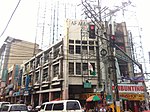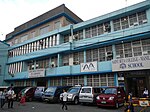Gota de Leche Building
Buildings and structures completed in 1915Buildings and structures in Sampaloc, ManilaImportant Cultural Properties of the PhilippinesJuan M. Arellano buildings

The Gota de Leche Building is a heritage site located in Sampaloc, Manila, Philippines. It was designated as an Important Cultural Property by the National Museum of the Philippines in August 2014. The cultural heritage site was named an Honourable Mention in the 2003 UNESCO Asia Pacific Heritage Awards.
Excerpt from the Wikipedia article Gota de Leche Building (License: CC BY-SA 3.0, Authors, Images).Gota de Leche Building
Loyola Street, Manila Sampaloc (Fourth District)
Geographical coordinates (GPS) Address Nearby Places Show on map
Geographical coordinates (GPS)
| Latitude | Longitude |
|---|---|
| N 14.6028 ° | E 120.9885 ° |
Address
Loyola Street
1015 Manila, Sampaloc (Fourth District)
Philippines
Open on Google Maps




